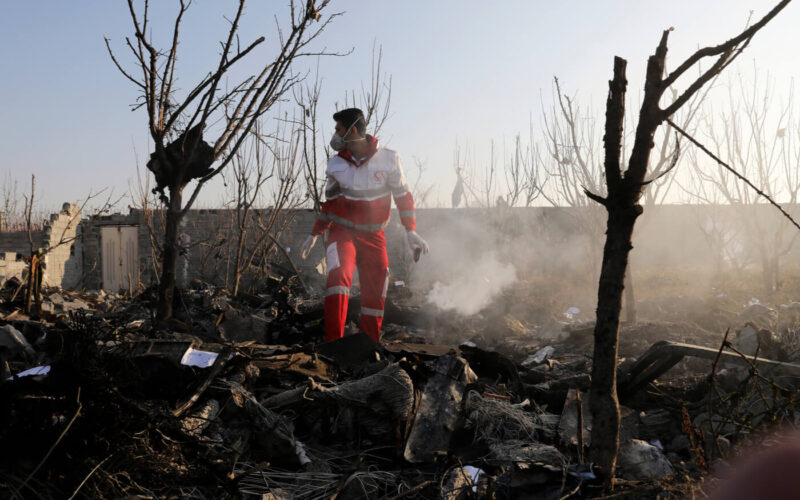The Ukraine International Airlines flight 752, which crashed in Iran on January 8, 2020, was allegedly shot down by an Iranian air defense system, as claimed by several U.S and British media quoting intelligence sources. Hours after the information was disclosed, Justin Trudeau, Prime Minister of Canada, was the first to confirm publicly having received similar indications from international allies and the Canadian intelligence service. “This may well have been unintentional,” Trudeau said.
Reacting to the declaration, the Iranian authorities have ruled out that hypothesis. “One thing is for certain, this airplane was not hit by a missile,” Ali Abedzadeh, chief of the Civil Aviation Organization of Iran (CAO), said during a press conference.
Complying with international regulations, the organization reaffirmed its invitation for the U.S. National Transportation Safety Board (NTSB), the National Bureau of Air Accidents Investigation of Ukraine (NBAA) to participate in the crash investigation. Besides, because the engines were partly manufactured by the company Safran (along with General Electric), the French Bureau of Enquiry and Analysis for Civil Aviation Safety (BEA) was also invited; a spokesperson of the organization confirmed its participation.
The CAO intends to download the data of the voice and flight recorders itself but did not rule out asking for technical assistance from Russia, Canada, France or Ukraine if needed. After the flight recorders have been recovered from the crash site by the Iranian search and rescue services, the authorities announced they would not hand them to the United States. Both flight recorders were damaged by the crash and the ensuing fire, according to the CAO, which said that the memory should be accessible nonetheless. The analysis could take a month.
Visual proof
A video, allegedly showing flight PS752 being hit by a missile, was analyzed by the investigative journalism team of Bellingcat, who was responsible for tracing back the origin of the weapon system that downed MH17. The footage shows an object, presumably a missile fired by a Tor-M1 surface-to-air system, impacting another object at high speed, which consequently catches fire and changes trajectory.
Using the surrounding structures, Bellingcat and Newsy localized the position of the onlooker in a residential area west of Tehran, which corresponds to the last known position of the flight PS752 before its transponder stopped emitting. The change of trajectory also matches the location of the crash site. The airplane was traveling near an Iranian missile base close to the city of Malard when it was hit.
The reason for someone to be filming the flight could be explained by the launches of two missiles. Indeed, U.S. intelligence sources told CBC that according to their satellite infrared readings, at least two launches were detected. The first missile may have missed or hit a non-critical part of the aircraft, and caught the attention of the recording witness.
Data seem to show that the transponder was not emitting anymore by the time the second missile hit its target, which could hint at previous damages. The fact that the plane did not explode is not contradictory to two missile hits. At this altitude, the cabin of the aircraft was likely not pressurized yet, thus the damage could cause no explosive decompression.
Anti-aircraft missiles have a charge made of a mix of explosive and metal projectiles and detonate when in the proximity of their target, throwing shrapnel at a perpendicular angle. Instead of exploding on impact with a direct hit, their objective is to disable critical systems to take the aircraft out of the sky.
Iran acquired about 30 Tor-M1 surface-to-air systems from Russia in the early 2000s.
The investigation compromised?
A second distressing element emerged online in the past days, with reports of heavy machinery clearing the crash site. A picture, allegedly showing the crash site, is raising concerns regarding the conduct of the investigation. It shows a piece of what seems like a wing fragment, bearing the marking “UR-PS”, being removed using a bulldozer.
Asked if that method of collecting wreckage is standard, air accident investigator Enriqueta Zambonini gave AeroTime her insight on the usual procedures in a crash investigation, based on Annex 13 of the International Civil Aviation Organization.
During an air accident investigation, “one of the first actions to be taken is to preserve the scene, since there is a lot of volatile evidence and because valuable information could be lost if the scene changes, intentionally or unintentionally,” Zambonini said. The investigator has also highlighted that collecting evidence requires precision and carefulness: “in the field, you must do it carefully, and again, trying not to damage or change anything.”
If the picture proved to be true, one could wonder if the use of a bulldozer is the best method to carefully collect wreckage for an investigation. On the morning of January 10, 2020, a CBS crew found the crash site cleaned.
CBS crew just visited the #Ukrainian airlines crash site west of Tehran. Nine am local time. Virtually all pieces of the plane were removed yesterday – say locals. Scavengers now picking site clean. No security. Not cordoned off. No sign of any investigators. pic.twitter.com/hhNJyokhjq
— Elizabeth Palmer (@elizapalmer) January 10, 2020
The Ukrainian investigators were reportedly given access to the wreckage on January 10, 2020. Furthermore, Vadym Prystaiko, Minister of Foreign Affairs of Ukraine, announced it received “important data” from Washington.
The European Commission has called for an “independent and credible” investigation respecting the rules of the International Civil Aviation Organization. “The Commission stands ready to provide any necessary assistance to the authorities conducting the investigation as it is crucial for us to guarantee the safety of our passengers, of European citizens traveling on airplanes inside and outside the European Union,” Commission spokesman Stefan de Keersmaecker said.

